Famiy: Ziphiidae
Genus: Mesoplodon
Species: M. grayii von Haast, 1876
Very little is known about Gray’s beaked whale. It is a rare whale even among beaked whales but is occasionally sighted. Because its characteristics are so clearly delineated, it is considered the “typical” beaked whale.
Physical Description: The body is uniformly stocky and higher than it is wide. The rostrum is long, thin and pointed. The upper jaw smoothly meets the melon, which dips to an indentation at the blowhole. The blowhole is wide and located slightly to the left of the forehead. Very well developed wishbone indentations are found on the throat.
Color: Gray-green ranging to pale brown-green on the ventral region.
Fins and Flukes: A comparatively large triangular dorsal fin has a slight falcate curve at the tip, located two-thirds of the way back on the body. Very short, pointed flippers are wider than those of any other Mesoplodon. Well-developed flukes point backward at their tips, with no median notch.
Length and Weight: This animal reaches 18 to 20 ft (5.5 to 6 m) and about 1,700 lb (770 kg).
Teeth: A pair of small triangular teeth is set well back from the tip of the lower jaw in males. Occasionally a row of small maxillary teeth is present in the upper jaw.
Feeding: Squid are known to be consumed.
Breathing and Diving: No information available.
Mating and Breeding: It has been suggested that 7 ft (2.1 m) calves are born in spring.
Herding: In 1874 a group of 28 Gray’s beaked whales beached themselves on Chatham Island off New Zealand, suggesting that the species does form herds. Otherwise unknown.
Distribution: South America, South Australia, New Zealand, Chatham Island, and Argentina; one record from the Netherlands.
Migration: No information available.
GRAY’S BEAKED WHALE DISTRIBUTION








